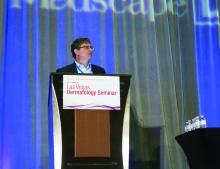LAS VEGAS – professor and chair of dermatology at the Medical College of Wisconsin, Milwaukee.
At the Skin Disease Education Foundation’s annual Las Vegas Dermatology Seminar, Dr. Gordon said that he uses phototherapy most in patients “who can’t get to all of the spots without it,” and in those whose disease is not having a huge impact on day-to-day life. “In my experience it’s best in people with thinner plaques, though I have some question over whether we can figure out if morphology really does correlate to respond to phototherapy,” he added. “We’re in the process of conducting a study to try and figure that out.”
From an immunologic standpoint, UVB decreases responsiveness of the interleukin-17 pathway and increases both cutaneous and circulating FoxP3+ cells, he said. Activation of p38 mitogen–activated protein kinase during phototherapy inhibits proinflammatory T-cell activation. In Dr. Gordon’s opinion, phototherapy is absolutely contraindicated in patients who have a photosensitivity reaction related to the UVB spectrum, while it is relatively contraindicated in those at high risk for skin cancer, including patients with multiple squamous cell carcinomas and those who have undergone organ transplantation. “I would argue that [the use of] photosensitizing drugs are not a contraindication,” he said. “Would I prefer that someone who’s had 54 [squamous cell carcinomas] not use phototherapy? Of course. But if it’s the only weapon I have, I’ll use it.”
Although clinicians have used phototherapy for about 100 years, early standards for clinical trials were different, compared with the rigor required of those conducted in the current era. Outcomes were not standardized, he said, and they were generally smaller trials that did not incorporate proper monitoring of adverse events. “Even with these weaknesses, we can get a general impression of how well UV works,” he said. In a 6-week, split-body trial of 11 patients from 20 years ago, researchers were able to induce clinical clearing in 82% of patients after narrowband UVB (the type most commonly used today), but in only 9% of patients after broadband UVB treatment (P less than .01) (J Am Acad Dermatol. 1999 Jun;40[6 Pt 1]:893-900).
Most clinicians commence narrowband UVB phototherapy treatment with three sessions per week and safely increase the dose to reach an effective level. Erythema can develop with overdosing. “If a patient can only come in twice weekly [for phototherapy treatment], that is okay,” Dr. Gordon said. “It takes a longer time getting to treatment goals. In my opinion, going down to once a week during the escalating phase of using phototherapy doesn’t work. Three times a week is better than twice a week during the escalating phase, but one time a week isn’t enough.”
Even for maintenance therapy, it remains a question whether limiting phototherapy to once every 2 or 4 weeks is sufficient for disease control. “I let the patient choose, but I like to go down to no less than once a week and hold people steady at that dose,” he said.
Purported risks of narrowband UVB phototherapy include photoaging, sunburn, herpes simplex virus reactivation, loss of the patient’s productive time, and development of skin cancer. “I don’t think we have good data about the effect of phototherapy on photoaging,” Dr. Gordon said. “Loss of productive time is my single biggest [complaint]. People are having trouble getting to work and having bosses who are not pleased with them [leaving work for treatment].”
As for the association between phototherapy and skin cancer, he noted that published studies that show statistical differences all incorporate psoralen-UVA photochemotherapy into their analyses. “There’s really no study that has demonstrated a significant impact on nonmelanoma skin cancers with the use of phototherapy [alone],” Dr. Gordon said. A British study of 3,867 psoriasis patients found no significant association between narrowband UVB treatment and basal cell cancer, squamous cell cancer, or melanoma (Br J Dermatol. 2008 Sep;159[4]:931-5). However, among those who also were treated with psoralen-UVA photochemotherapy, there was a small increase in basal cell cancer.
In a more recent Swedish study of 162 psoriasis patients who were treated with UVB phototherapy, researchers found that, after controlling for age, the risk of skin cancer was associated with the number of treatments, but not with the type of UVB lamp used (Acta Derm Venereol. 2014 Jul;94[4]:425-30). They reported that overall, the risk of malignancy in the UVB-treated patients did not exceed that in the general population.
Dr. Gordon concluded his presentation by noting that home-based UVB phototherapy is gaining in popularity and is comparable with in-office UVB in terms of accuracy and efficacy (BMJ. 2009;338:b1542). Because of convenience and decreased time away from work, he said, “it’s easier for patients ... and it’s probably cheaper in the long run.” The National Psoriasis Foundation web site includes a list of home UVB equipment.
Dr. Gordon disclosed that he is a consultant with AbbVie, Almirall, Amgen, Bristol-Meyers Squibb, Celgene, Dermavant, Eli Lilly, Janssen, Leo, Novartis, Ortho Dermatologics, Pfizer, Sun Pharma, and UCB. He has also received grant/research support from AbbVie, Bristol-Myers Squibb, Celgene, Eli Lilly, Janssen, and Novartis.
SDEF and this news organization are owned by the same parent company.


